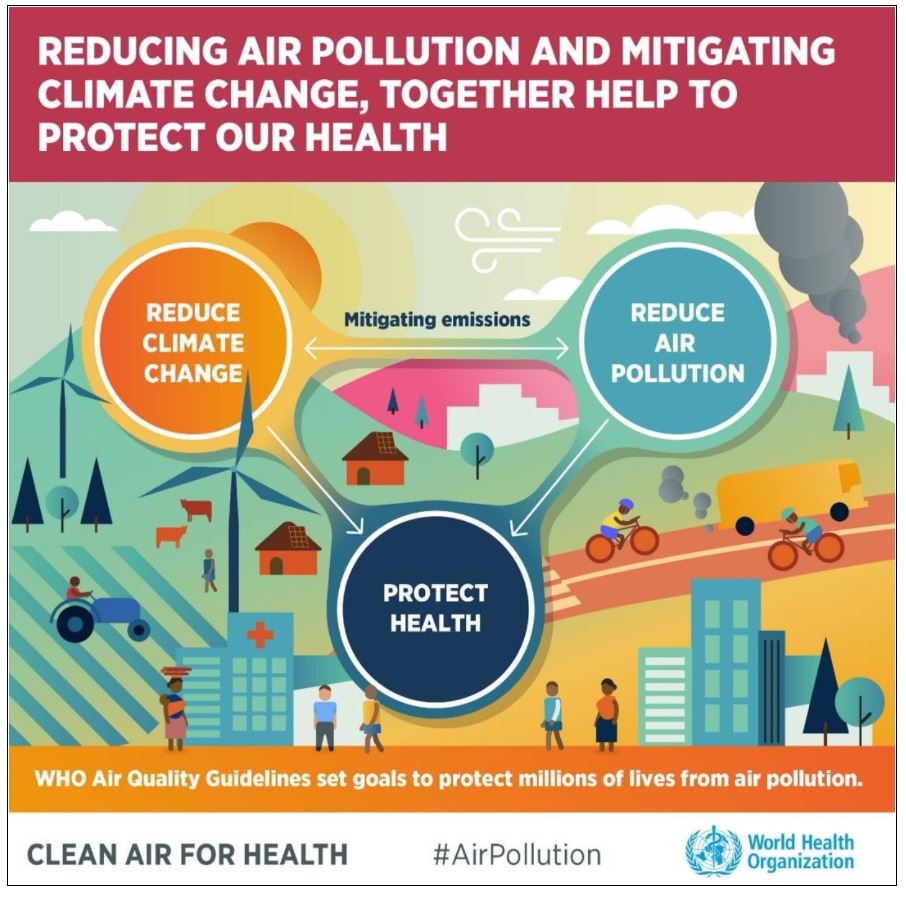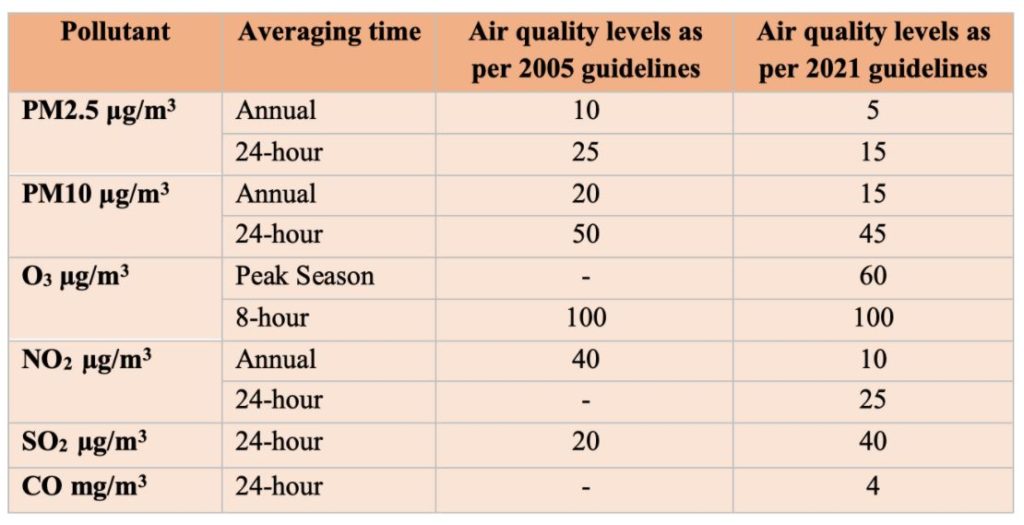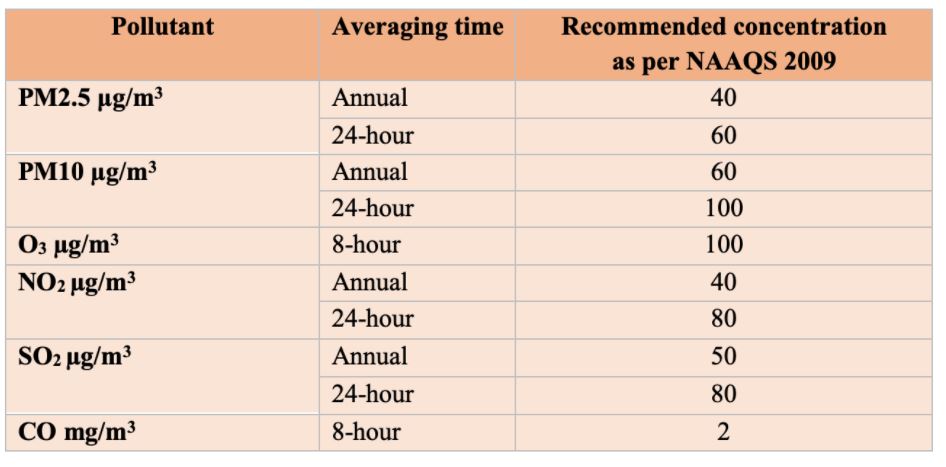Recently, the WHO released the revised guidelines for the ‘Air Quality Standards’. This is the first revision after the year 2005. The revised standards are stringent and reduce further, the limit of acceptable levels of air pollutants. Here is a review of these revised standards along with a status check of How India fares.
Air pollution has emerged as the single biggest environmental threat to human health as it contributes significantly to the disease burden. The disease burden is the highest in low and middle-income countries. According to WHO’s estimates, over 7 million deaths which mainly occur from non-communicable diseases can be attributed to the combined effects of ambient (outdoor) and household air pollution. Millions more end up being sick. Stroke, heart attacks, lung cancer, and chronic obstructive pulmonary disease (COPD) are some diseases caused by exposure to air pollutants. In fact, new research has also indicated the association between prenatal exposure to high levels of air pollution and developmental delay at age three, as well as psychological and behavioural problems later in life such as symptoms of attention deficit hyperactivity disorder (ADHD), anxiety and depression.

WHO released revised guidelines for ‘Air Quality Standards’ after 15 years
Noting that air pollution can cause harm at much lower levels than previously thought, the WHO recently released revised air quality guidelines. The air quality guidelines are a set of evidence-based recommendations of limit values for specific air pollutants, developed to help countries achieve air quality for public health. Exceeding the stipulated levels will add a risk to public health. The WHO released the first set of guidelines for air quality in 1987 and since then, these have been updated in 1997 and 2005 on the basis of prevalent conditions and health studies, to ensure that the guidelines continue to be relevant. The guidelines also support policy formulation for air quality management across the world. Prior to the 2021 guidelines, the last global revision was released in 2005. The Air quality guidelines serve as a global target for national, regional and city governments to work towards improving their citizen’s health by reducing air pollution.
These guidelines are not legally binding
It should be noted that the guidelines are not legally binding. Governments across the world may use these guidelines as a reference, or in such ways depending on their economic capacity, technical capabilities, prevalent air quality management policies, and other social & political factors. Before adopting the WHO’s guidelines, the local conditions are taken into consideration by respective governments. Such considerations are important in the case of under-developed and developing countries where the technology and resources to fight pollution are less than compared to the developed countries.
Targets have been set for five common pollutants
The WHO’s latest guidelines are applicable worldwide to both outdoor and indoor environments. It recommends permissible pollution levels and interim targets for common air pollutants which not only affect human health but are also responsible for climate change. These are-
- Particulate matter (PM)
- Ozone (O3)
- Nitrogen dioxide (NO2)
- Sulphur dioxide (SO2)
- Carbon Monoxide (CO)
Further, the guidelines also include qualitative good practice recommendations for black carbon/elemental carbon, ultrafine particles (<=1um) and particles derived from sand and dust storms.
Short term exposure and long-term exposure targets have been set
The following table compares the 2005 and 2021 recommendations of air quality levels for the above-specified pollutants. These definitions help in understanding the table-
- μg is a microgram which is equivalent to one millionth (1×10−6) of a gram
- PM2.5 refers to fine particulate matter with a diameter of 2.5 microns or less and PM10 refers to coarse particulate matter with a diameter of 10 microns or less
- Annual and peak season refer to long-term exposure. Peak season is defined as the six consecutive months of the year with the highest six-month running-average ozone concentration. 24-hour and 8-hour refer to short-term exposure.

The revised guidelines are stringent in many aspects
According to the latest guidelines, the annual average for PM2.5 should not exceed 5 µg/m3 of air while the 24-hour average should not exceed 15 µg/m3 of air. In the 2005 guidelines, the limit for annual average was 10 µg/m3and that for 24-hour average was 25µg/ m3. Similarly, the annual average of PM10 should not exceed 15 µg/m3 of air while the 24-hour average should not exceed 45 µg/m3of air. The earlier limits were 20 µg/m3 and 50 µg/m3 respectively.
Meanwhile, for O3, the recommended level for a peak season has been set at 60 µg/ m3 (the average of daily maximum 8-hour mean ozone concentrations). This was not specified in the previous 2005 guidelines. Further, the average daily 8-hour concentration has not been revised and the limit continues to be 100 µg/m3.
The new guidelines have also set levels for 24-hour levels of NO2 and CO. The 24-hour concentration of NO2 should not exceed 25 µg/m3 while of CO should not exceed more than 4 mg/m3 in the 24-hour period. At the same time, the annual NO2 level limit has been reduced from 40 µg/m3 to 10 µg/m3. However, the 24-hour level of SO2 has been increased from 20 µg/m3 to 40 µg/m3.
90% of the World’s population lived in cities where the PM2.5 level was more than WHO’s 2005 limit
As explained previously, the WHO has further reduced levels of key air pollutants in the latest guidelines as compared to the 2005 ones. However, WHO stated that, in 2019, more than 90% of the world’s population lived in places where air quality levels exceed WHO’s 2005 air quality guidelines for annual mean PM2.5 concentration. Since the new guidelines are more rigid, a greater quantum of the population would be living in areas where these standards are not met. The implementation of the new guidelines will also be challenging for countries that adopt these recommendations.
India’s National Ambient Air Quality Standards (NAAQS) is lenient
India follows the National Ambient Air Quality Standards (NAAQS) for ambient air quality notified by the Central Pollution Control Board in 2009 under the Air (Prevention and Control of Pollution) Act, 1981. The NAAQS is more lenient and does not meet the WHO’s recommended standards. The levels stipulated by NAAQS exceed even the WHO’s recommended standards from 2005, and farther away from the 2021 guidelines. Even at these lower levels, many cities in India fail to even meet the targets under NAAQS, as per a government response in Lok Sabha in August 2021. According to NAAQS, the limits set for the six pollutants seen earlier is as follows:

It may be time for India to revise NAAQS
As per estimates, most Indian metros and big cities would have particulate matter levels at more than 5-fold and in some cases more than 15-fold compared to the latest WHO standards. Many Indian cities find their place in the top 100 most polluted cities in the world. Since air pollution has become an important public health concern, it is time to revise the NAAQS.
The government has been implementing the National Clean Air Programme (NCAP) since 2019 as a national-level strategy. The NCAP targets to achieve a 20 to 30% reduction in particulate matter by 2024 across the country. The long-term goal of NCAP is to meet the prescribed annual average ambient air quality standards at all locations in the country. As observed earlier, these targets may not be sufficient to meet the WHO or even the standards set forth in NAAQS. Hence, an aggressive strategy to reduce these levels is the need of the hour in addition to revising the NAAQS.
Featured Image: Air Quality Standards


